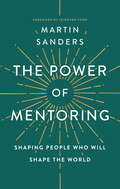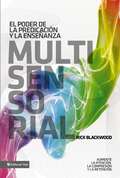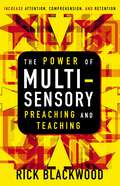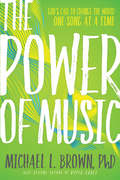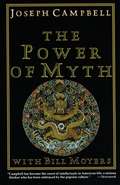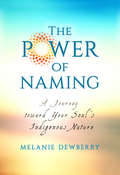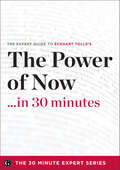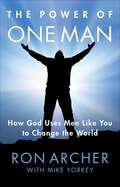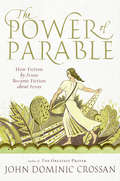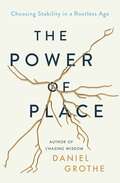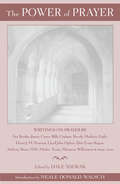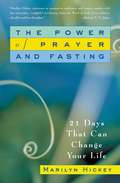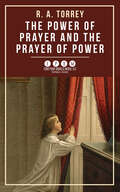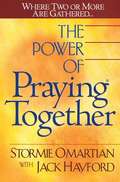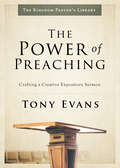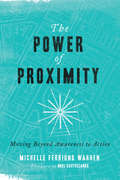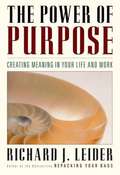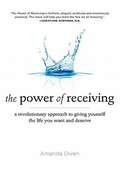- Table View
- List View
The Power of Mentoring: Shaping People Who will Shape the World
by Martin SandersThe Power of Mentoring is a groundbreaking guide for mentoring the next generation of Christian leaders. With its variety of practical, insightful mentoring models, The Power of Mentoring provides motivation for mentoring involvement, new approaches and skill-building exercises and implementation strategies. This ideal resource includes: Key thoughts questions for reflection, Action plans, A "Life Plan" for self-evaluation, Accountability questions and additional suggested resources .
The Power of Mind: A Tibetan Monk's Guide to Finding Freedom in Every Challenge
by Khentrul Lodrö T'hayé RinpocheA modern guide to lojong—ancient Buddhist techniques for transforming all circumstances, including pain, anxiety, and stress, into mental well-being that benefits us and the people around us.We&’ve all heard platitudes about cultivating love and compassion, but how can we actually develop these qualities in ourselves and—crucially—share them in our world? The Power of Mind provides the proven path of lojong, or mind training, for changing our experience from the inside out. Regardless of what&’s happening in our lives, Khentrul Rinpoche teaches that our route to freedom lies in our minds. A thousand years ago, the Indian saint Atisha risked his life to seek out lojong teachings in Indonesia, and then brought them to Tibet, where they flourished and spread to the rest of the world. This book introduces those teachings—the Seven Key Points of Mind Training—which have been passed down from teacher to student for centuries. Khentrul Rinpoche was inspired by his own teachers, who like alchemists, were able to follow these techniques during the Cultural Revolution and transform their immense suffering into something positive. The Power of Mind guides the reader through these transformative practices one by one—from recognizing the value of our human life to overcoming the sources of suffering, together with meditation advice for incorporating these insights into our daily lives. This wisdom is accessible to everyone—whether Buddhist or not. As Khentrul Rinpoche states, &“Peace and happiness can be attained, but not by searching for something in the outside world. They start within us then extend out to the entire globe.&”
The Power of Mother Love: Strengthening the Bond Between You and Your Child
by Brenda HunterMany women--especially the mothers of young children--feel their role as "just a mother" is undervalued today. This book highlights the incredible--although sometimes unrealized--influence that a mother has on her children and her society.After decades of scientific and psychological study, there is overwhelming evidence that "mother love" has an enormous, permanent impact in shaping the character and life of a child. As both a psychologist and a Christian, Brenda Hunter presents a convincing argument that this loves is even more powerful and far-reaching than our culture has yet realized. And the impact of this powerful love impacts not only the child, but the mother herself and the society as a whole.Hunter affirms the immeasurable value of the mothering role from a Christian perspective while realistically addressing women's greatest questions and concerns. Hunter clearly reveals how mother love positively affects the way a woman defines herself.From the Hardcover edition.
The Power of Multisensory Preaching and Teaching: Aumente la atención, la comprensión y la retención
by Rick BlackwoodThis practical guide shows the power of multisensory communication as contrasted with monosensory speaking. Using multiple senses is shown by research to increase learner attention, comprehension, and retention. Any preacher or teacher can incorporate more sense appeal resulting in more compelling, clear, and memorable messages with greater impact.
The Power of Multisensory Preaching and Teaching: Increase Attention, Comprehension, and Retention
by Rick BlackwoodMost preaching and teaching in the church engages only one of the senses—hearing. In The Power of Multisensory Preaching and Teaching, Rick Blackwood shows how recognizing and engaging the multiple senses of the congregation can lead to greater impact. Blackwood presents both biblical evidence and scientific research showing that the more senses we stimulate in teaching and preaching, the greater the levels of learner attention, comprehension, and retention. Blackwood addresses both the “why” and the “how” of multisensory communication. Regardless of one’s current skill level, this practical book can help anyone add multi-sensory elements to messages in order to take communication to the next level—more compelling, clear, and memorable. As a result of reading this book readers can be more effective as a communicator and teacher. The book includes tools, examples, and worksheets.
The Power of Music: God's Call to Change the World One Song at a Time
by Michael L. BrownMusic can either Connect You to God or Drive You to the Devil. God created the human race to enjoy music and to make music, and through music the world has been dramatically changed—for good and for evil. In this fascinating book Michael L. Brown takes the reader on a journey through the history of music—from classical to rock and from hip-hop to gospel—showing just how transformative music has been and how much God wants to use it to change the world again. Brown contends that it is time for all Christians to make a concerted effort to recover the potential of anointed music and song—in our assemblies and in society, in our services and on the streets, in studios and in schools. The counterculture revolution of the 1960s only succeeded with the help of satanically inspired music and mind-altering drugs. Could it be that today&’s Jesus revolution can only succeed with the help of Spirit-inspired music and a life-altering encounter with God? What else will produce the necessary change in our perspective? After reading this book, believers will never again listen to music the same! They will finally understand its power and divine origin, but more importantly they will know how God wants to use it to usher in a global outpouring that will change the world forever.This book will show you how music can either indoctrinate or educate you, spark rebellion or patriotism, and drive you to the devil or draw you closer to God.&“This book will stir up musicians, artists, and worshippers everywhere to dive deeper into an appreciation and adoration of the One Himself who created sounds, songs, and melodies!&” —BECKAH SHAE, Dove Award-Nominated Singer/Songwriter&“Musicians and non-musicians alike will be inspired by the powerful ways God intends to use music in today&’s end-time drama.&” —BOB SORGE, Author of Exploring Worship: A Practical Guide to Praise and Worship&“Dr. Brown has written a must-read for all musicians, singers, and songwriters who desire to harness the power of music to glorify Jesus, change the atmosphere, and release heaven&’s sound on the earth.&” —KELANIE GLOECKLER, Worship Leader and Songwriter, Executive Director of Access Worship International
The Power of Myth
by Joseph Campbell Bill MoyersNATIONAL BESTSELLER • An extraordinary book that reveals how the themes and symbols of ancient narratives continue to bring meaning to birth, death, love, and war. The Power of Myth launched an extraordinary resurgence of interest in Joseph Campbell and his work. A preeminent scholar, writer, and teacher, he has had a profound influence on millions of people—including Star Wars creator George Lucas. To Campbell, mythology was the &“song of the universe, the music of the spheres.&” With Bill Moyers, one of America&’s most prominent journalists, as his thoughtful and engaging interviewer, The Power of Myth touches on subjects from modern marriage to virgin births, from Jesus to John Lennon, offering a brilliant combination of intelligence and wit. From stories of the gods and goddesses of ancient Greece and Rome to traditions of Buddhism, Hinduism and Christianity, a broad array of themes are considered that together identify the universality of human experience across time and culture. An impeccable match of interviewer and subject, a timeless distillation of Campbell&’s work, The Power of Myth continues to exert a profound influence on our culture.
The Power of Naming
by Melanie DewberryWho are you, really? This is the central question. The question you might have been asking yourself all these years. Who are you without your title, your gender, your talent, your weight, your income, or your personality? If you strip away all of your niceties, all those embellishments that you’ve added to your persona to be accepted, what is left? If you wriggle out of all the identities that others have foisted on you, if you release all the ways you smooth out your rough edges so you can belong and feel safe, who are you? What is your core identity?The Power of Naming: A Journey toward Your Soul’s Indigenous Nature is a beautiful guide to answering your soul’s yearning to be known, to live on purpose, and to be authentic. To hear and elicit your name, you will need to be honest with yourself and admit that deep down inside you have always had at least an inkling of your essence, but you’ve played a game of hide-and-seek with your soul.Through The Power of Naming, peaceful warriors are born, false identities and labels are cast off, and a deeper understanding of the true soul is unearthed. As you work through the chapters of this book, learning to apply the teachings imbued with the author’s rich Native American and African American background, you will rediscover who you are and experience a new sense of freedom, love, and alignment with your highest self.
The Power of Now . . . in 30 Minutes: The Expert Guide to Eckhart Tolle's Critically Acclaimed Book
by Eckhart TolleThe Power of Now ...in 30 Minutes is the your guide to quickly understanding Eckhart Tolle's best- selling book on the key to happiness, The Power of Now: A Guide to Spiritual Enlightenment. In The Power of Now, Eckhart Tolle shares the knowledge and enlightenment of his life-changing spiritual awakening. Drawing from his wisdom as a spiritual counselor as well as teachings from early philosophers such as Buddha and Christ, The Power of Now proposes that the key to true contentment and pain-free existence, is to live completely in the Now. A manual for achieving fulfillment, The Power of Now explains how quieting thoughts, emptying the mind, and being present and aware at all times can lead to inner solitude, joy, and peace. Use this helpful guide to understand the key ideas behind The Power of Now in a fraction of the time, with tools such as: A concise synopsis examining the spiritual principles in The Power of Now In-depth analysis of key concepts from The Power of Now, such as the Pain-Body, living in the Now, and what it means to experience true enlightenment Helpful examples to apply these philosophical concepts to your everyday existence Extensive recommended reading list and bibliography relevant to The Power of Now As with all books in the 30 Minute Expert Series, this book is intended to be purchased alongside the reviewed title The Power of Now: A Guide to Spiritual Enlightenment.
The Power of One Man: How God Uses Men Like You to Change the World
by Ron ArcherWhat can one man do? History is filled with world-changing events that turned on the hinge of a single person taking action. Their decisions and words shaped the world later generations came to inhabit. In The Power of One Man, author Ron Archer examines biblical figures who changed the world in which they lived, then applies those lessons to the challenges men face today—deftly weaving the narrative with stories of both failure and success in his own life in a way that is not only educational, but inspirational. Most of the social problems in our culture stem from an epidemic of fatherlessness. But as Ron&’s own life demonstrates, God has a plan to redeem and restore those areas by redeeming and restoring men themselves—one individual at a time. What can God do with just one man? Anything He wants to—if you let Him.
The Power of Oral Culture in Education: Theorizing Proverbs, Idioms, and Folklore Tales
by Njoki Nathani Wane Ardavan EizadiradThis volume explores the importance of inter-generational oral culture and stories that transcend time, space, and boundaries transmitted historically from one generation to the next through proverbs, idioms, and folklore tales in different geographical and spatial contexts. These important stories and their embedded life lessons are introduced, explained, and supplemented with pre and post educational activities and lesson plans to be used as learning resources. The centering of orality as a tool and medium for educating the future generation is a reclamation and reaffirmation of Indigeneity, Indigenous knowledges. and non-hegemonic approaches to support students in a socio-culturally sustaining manner. Through this understanding, this book explores the interconnectedness between culture, traditions, language, and way of life through oral storytelling, sharing, and listening.
The Power of Oratory in the Medieval Muslim World
by Linda G. JonesOratory and sermons had a fixed place in the religious and civic rituals of pre-modern Muslim societies and were indispensible for transmitting religious knowledge, legitimizing or challenging rulers, and inculcating the moral values associated with being part of the Muslim community. While there has been abundant scholarship on medieval Christian and Jewish preaching, Linda G. Jones's book is the first to consider the significance of the tradition of pulpit oratory in the medieval Islamic world. Traversing Iberia and North Africa from the twelfth to the fifteenth centuries, the book analyzes the power of oratory, the ritual juridical and rhetorical features of pre-modern sermons, and the social profiles of the preachers and orators who delivered them. The biographical and historical sources, which form the basis of this remarkable study, offer abundant proof of cultural exchange between al-Andalus and the eastern regions of the Islamic empires, as preachers traveled back and forth between the great cities of Cordoba, Qayrawan, Baghdad, and Cairo. In this way, the book sheds light on different regional practices and the juridical debates between individual preachers around correct performance.
The Power of Parable: How Fiction by Jesus Became Fiction about Jesus
by John Dominic CrossanIn 1969, I was teaching at two seminaries in the Chicago area. One of my courses was on the parables by Jesus and the other was on the resurrection stories about Jesus. I had observed that the parabolic stories by Jesus seemed remarkably similar to the resurrection stories about Jesus. Were the latter intended as parables just as much as the former? Had we been reading parable, presuming history, and misunderstanding both? -from The Power of Parable So begins the quest of renowned Jesus scholar John Dominic Crossan as he unlocks the true meanings and purposes of parable in the Bible so that modern Christians can respond genuinely to Jesus's call to fully participate in the kingdom of God. In The Power of Parable, Crossan examines Jesus's parables and identifies what he calls the "challenge parable" as Jesus's chosen teaching tool for gently urging his followers to probe, question, and debate the ideological absolutes of religious faith and the presuppositions of social, political, and economic traditions. Moving from parables by Jesus to parables about Jesus, Crossan then presents the four gospels as "megaparables." By revealing how the gospels are not reflections of the actual biography of Jesus but rather (mis)interpretations by the gospel writers themselves, Crossan reaffirms the power of parables to challenge and enable us to co-create with God a world of justice, love, and peace.
The Power of Place: Choosing Stability in a Rootless Age
by Daniel GrotheAcclaimed teaching pastor Daniel Grothe speaks to the sense of loneliness that many feel in today's age of hypermobility and noncommittal wandering, reminding us of the ancient vow of stability and teaching us how we can lead a richer life of friendship, community, and purpose.Unlike previous generations that had to stay put, many people today have unprecedented access to a lifestyle of mobility. We can explore and bounce from place to place, never settling down or making anywhere home. And while it feels freeing to be able to try something new whenever we want--whether it's a new job, a new city, a new group of friends, or even a new church--somewhere along the way, we discover we're missing something. We may be paying our bills and have a roof over our heads, but we're lonely and unfulfilled, disconnected and unsatisfied. What's that all about? What is the missing piece?In The Power of Place, pastor Daniel Grothe speaks to the human ache for home and makes a countercultural case for staying put. He calls us to reject the myth of Christian individuality and instead embrace the richness of commitment and community, arguing that we must stay in one place as long as we can, plant our lives, and let roots take hold. Because only then can we experience the deep fulfillment, friendship, and fruitfulness God created us for.
The Power of Positive Energy: Everything You Need to Awaken Your Soul, Raise Your Vibration, and Manifest an Inspired Life
by Tanaaz ChubbFrom the founder of ForeverConscious.com comes a guide to cultivating positive feelings and projecting positive energy.Positive energy creates positive outcomes. But how do you get the good vibes going? It all comes down to understanding and embracing the innate and energetic power of your soul. With the guidance of Tanaaz Chubb, creator of ForeverConscious.com, you will begin a journey that will give rise to an understanding of your soul&’s energy and its connection to the Universal energy all around us. You will free yourself from negativity, fears, and the parts of your life that are no longer serving you. You will tune into the powerful vibrations that allow you to live your life to the fullest potential. Tanaaz shares the secrets to awakening positivity through introspective and inspiring meditations, writing prompts, and exercises including: -Ten-Minute Soul Connection Meditation -Switching a Negative Thought for a Positive One -Identifying Your Self-Limiting Beliefs -A Positive Energy Cleanse -Releasing the Past It&’s time to tune into the positive vibrations that exist within you, and around you. You can rise above negative influences, reclaim your power, and manifest a life that is easy, joyous, and inspired!
The Power of Prayer
by Dale SalwakTo explain the power of prayer, Dale Salwak went to more than 30 distinguished spiritual leaders, thinkers, and writers and asked them to offer a few words of wisdom and advice. The result is this book -- a compendium of enlightening meditations on prayer.
The Power of Prayer and Fasting: 21 Days That Can Change Your Life
by Marilyn HickeyMany believe prayer combined with fasting is an archaic discipline practiced only by early believers. Yet together, prayer and fasting form a powerful tool, says Bible teacher Marilyn Hickey, for helping us to overcome evil, achieve wholeness, and experience revival. The benefits of prayer and fasting are both physical and spiritual. In fact, this combination is important to believers in every age because it: Inspires spiritual cleansing through intense contact with the Lord, Makes us more sensitive to the Holy Spirit's leading, Actually creates energy, tightens focus, and unifies groups of people, Promotes healing within the body, Breaks spiritual yokes of bondage, Revives our spirits to serve God.
The Power of Prayer and the Prayer of Power
by R. A. TorreyTap into the unlimited power of God through prayer with this classic handbook from American evangelist R.A. Torrey. How should you pray? Who can pray? Why pray at all? Torrey's insightful answers to these questions, along with his discussion of the freedom, peace, and security available though communication with God, has made this a must read for those seeking a closer relationship with Christ.
The Power of Praying Together
by Stormie Omartian Jack HayfordStormie Omartian tells of her salvation experience and learning to pray. As a member of Jack Hayford's church, she tells of her growth in christ through prayer.
The Power of Preaching: Crafting a Creative Expository Sermon (Kingdom Pastor's Library)
by Tony EvansThe No-Nonsense Preaching Manual Every Pastor Needs The first book in the Kingdom Pastor&’s Library from Tony Evans, The Power of Preaching will help you be faithful to the Word of God and preach with power and conviction. From the practice of preparation to learning to choose subjects wisely, this book offers you a preaching education from one of the most trusted and effective voices in ministry. It also includes important lessons on: Bible study methods & expository preachingThe development and use of illustrationsThe cadence of deliveryLearn the essentials of preaching a powerful message from the gifted, veteran pastor, Tony Evans. The Kingdom Pastor&’s Library is a series of books that brings you a concise, complete pastoral philosophy and training from Tony Evans.Faithful. Powerful. Practical. Become a Kingdom Pastor today.
The Power of Preaching: Crafting a Creative Expository Sermon (Kingdom Pastor's Library)
by Tony EvansThe No-Nonsense Preaching Manual Every Pastor Needs The first book in the Kingdom Pastor&’s Library from Tony Evans, The Power of Preaching will help you be faithful to the Word of God and preach with power and conviction. From the practice of preparation to learning to choose subjects wisely, this book offers you a preaching education from one of the most trusted and effective voices in ministry. It also includes important lessons on: Bible study methods & expository preachingThe development and use of illustrationsThe cadence of deliveryLearn the essentials of preaching a powerful message from the gifted, veteran pastor, Tony Evans. The Kingdom Pastor&’s Library is a series of books that brings you a concise, complete pastoral philosophy and training from Tony Evans.Faithful. Powerful. Practical. Become a Kingdom Pastor today.
The Power of Proximity: Moving Beyond Awareness to Action
by Michelle Ferrigno Warren Noel CastellanosWe can see evidence of injustice all around us, whether in continuing incidents of racial inequality or in the systemic forces that disenfranchise people and perpetuate poverty. It's important to learn about the world's inequities and to be a voice for the voiceless any way we can. But in an age of hashtag and armchair activism, merely raising awareness about injustice is not enough. Michelle Warren knows what is needed. She and her family have chosen to live in communities where they are "proximate to the pain of the poor." This makes all the difference in facing and overcoming injustice. When we build relationships where we live, we discover the complexities of standing with the vulnerable and the commitment needed for long-term change. Proximity changes our perspective, compels our response, and keeps us committed to the journey of pursuing justice for all. Move beyond awareness and experience the power of proximity.
The Power of Purpose: Creating Meaning in Your Life and Work
by Richard J. LeiderMany people these days are asking hard questions about the very meaning of work. More than ever they are seeking a better fit between what they are doing for a living and what they do because they love to. Much more than a book about finding a job, "The Power of Purpose" is an original guide to discovering our calling -- the work we love to do. Based on many interviews over a ten year period, it helps readers find joy and deeper meaning in their work lives.
The Power of Receiving: A Revolutionary Approach to Giving Yourself the Life You Want and Deserve
by Amanda OwenThe Power of Receiving Journal is a companion to The Power of Receiving: A Revolutionary Approach to Giving Yourself the Life You Want and Deserve (Tarcher/Penguin, 2011) by Amanda Owen. The Power of Receiving Journal includes: Quotes to inspire you. A section to write your daily gratitudes. A month overview page where you can write your current goal and enter what you received throughout the month in The Big Circle. Four pages each month to journal your thoughts, ideas and experiences. The Power of Receiving Journal also includes: A Receptive States word-list The Three Steps to Receiving The Top Ten Features of Skilled Receivers A ‘No Suffering Allowed! No Suffering Aloud!’ leaflet
The Power of Reiki: An ancient hands-on healing technique
by Tanmaya HonervogtWhether you are looking to ease the effects of chronic illness or would like to have more energy on a daily basis, the age-old wisdom of Reiki offers the help you seek. Reiki is a form of touch healing with its roots in Buddhist Sanskrit scriptures. The Power of Reiki is filled with easy-to-follow instructions, accompanied by helpful photographs.
